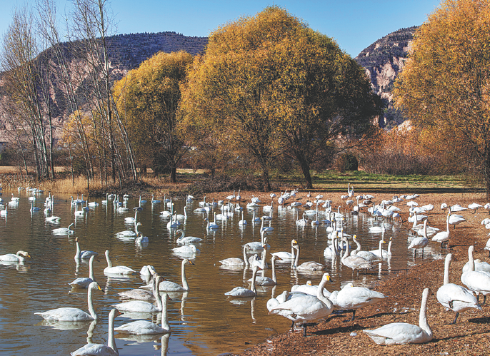Green policies improve lives in Yellow River drainage area
Updated: 2021-12-10

Swans are spotted in a wetland park near the Yellow River in Pinglu county, showing the improving ecological environment in the region. [Photo by Liu Wenli for China Daily]
Integrated development provides new pathways for people to raise incomes
During the 12th provincial congress of the Communist Party of China, which was held in Taiyuan from Oct 25-29, Shanxi's Party secretary Lin Wu once again reiterated Shanxi's role in safeguarding the ecological well-being of the Yellow River.
At the congress, Lin said Shanxi's targets are to become an important experimental zone for ecological protection and for high-quality development in the Yellow River drainage region.
The 5,464-kilometer-long Yellow River is the second-longest river in China. It is regarded as the mother river of the nation as it has nurtured the Chinese civilization for millennia.
The Shanxi section of the Yellow River is 965 km in length. More than 73.1 percent of the land in Shanxi belongs to the river's drainage basin, which is home to 73.4 percent of the province's population and takes up 75.8 percent of Shanxi's GDP.
As Shanxi is located on the Loess Plateau, where soil erosion has been a severe challenge for millennia, it holds an important position in protecting the ecological environment of the Yellow River.
Shanxi began to implement its strategy to develop itself into an important experimental zone for ecological protection and high-quality development in the Yellow River drainage region in 2017. And Shanxi's authorities have put the strategy high on their work agendas.
In late November, Shanxi Party chief Lin Wu and Shanxi Governor Lan Fo'an made tours of the cities and counties along the Yellow River and its tributaries, to see how work is proceeding in areas relating to soil erosion control, environmental improvements and green development.
Lin visited the famed Hukou Waterfalls on the Yellow River in the county of Jixian. During the trip, he suggested protection of the Yellow River's ecological environment be integrated with green development.
"The growth of Hukou's tourism industry should be combined with the development of unique local cultural resources," Lin said.
The Party chief noted that rational plans for industrial development are crucial to the environmental protection and high-quality development of the Yellow River drainage region.
"Safeguarding ecological wellbeing, especially ensuring the rational utilization of water resources, should be the prerequisite for local growth," Lin said. "So environmentally friendly industries such as forestry, tourism, modern agriculture and eco-friendly manufacturing should be the highlights."
The village of Xuegong in Linyi county, for instance, stands on the mud flat of the Yellow River.
The village's latest practice is to combine farming with tourism by building a unique ecological and industrial chain.
"We have turned the former grain fields on the mud flat into lotus farms," said an official in the village. "When lotus flowers bloom in the summer, our village becomes a popular destination for sightseeing tourists."
There are also hairy crabs and crawfish in the lotus ponds, forming a wetland ecosystem featuring aquatic plants and animals. The official said such a system cannot only improve the water quality for the Yellow River but also create a destination for study tours for students.
In addition to tourism, the sales of hairy crabs, crawfish, and lotus roots and seeds can also bring revenues to local residents.
The village of Longmenyuan in Liulin county is another example of how improving the environment can benefit the livelihoods of locals.
The village is located at heart of the Lyuliang Mountains, which used to be one of the regions that suffered from the most severe soil erosion.
Because of the infertile land as a result of long-term soil erosion, Longmenyuan used to be one of the poorest villages in Shanxi as residents could hardly support their livelihoods relying on grain farming.
The village started a massive afforestation move several years ago, planting trees that can both improve the ecological environment and generate revenues.
Over the past years, the village has planted more than 4,000 hectares of trees, including 2,700 hectares of walnut trees.
Zhao Qiulin, a Longmenyuan villager, is one of the beneficiaries of the project.
He said he is now a forestry worker in the village, earning a stable income from planting and taking care of the trees.
"Villagers can also have additional incomes from selling walnuts," Zhao said.
Du Haiwang, head of the forestry bureau of Liulin county, said the Longmenyuan afforestation project is funded by the county government as part of its efforts in poverty alleviation.
"In addition to Longmenyuan, similar projects have been implemented in other underdeveloped villages in Liulin," Du said. "This program has benefited about 13,000 residents in total."
The official noted that local forestry experts have selected a number of plant varieties, including walnuts and chestnuts as well as medical herbs for the local afforestation move, which can both stabilize soil and generate benefits.
"As a result of increasing vegetation coverage, there are fewer soil erosion cases in Liulin even during severe floods," Du said. "The improved environment has also led to a substantial increase of grain output, although the proportion of grain farming in the local economy has decreased."
The Fenhe River in Shanxi is the second-largest tributary of the Yellow River. Improving its environment is also crucial to the environment of the Yellow River.
The Shanxi provincial government and governments of regions along the river have made great efforts to improve its environment in recent years.
One of the efforts is a campaign to develop an ecological tourism belt along Fenhe, which has brought a fundamental change to the river.
Through controlling pollution, increasing water supply and greening both banks of the river, Fenhe has grown into a river with better water quality, a new attraction for tourists, and a pleasant habitat for humans and wildlife, according to local officials.
Shanxi's innovative practice for river management is to appoint chiefs for each river. A river chief is usually the head of the local government according to each section of the river. It can be the head of the township, county, city or provincial government.
There are a total of 18,000 river chiefs in Shanxi province and their responsibility is to ensure that the rivers can maintain a good water quality and good ecological environment.
Guo Yanjie contributed to this story.



